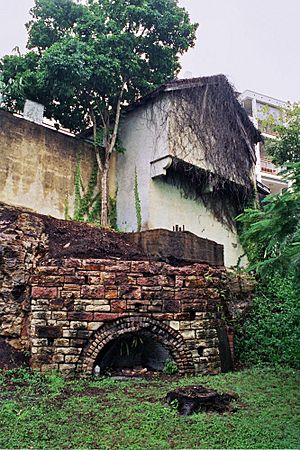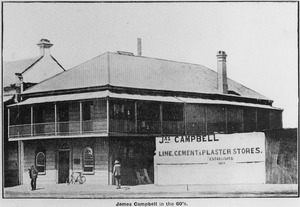Langshaw Marble Lime Works facts for kids
Quick facts for kids Langshaw Marble Lime Works |
|
|---|---|

Remains of the Langshaw Marble Lime Works, 2003
|
|
| Location | 12 Julius Street, New Farm, City of Brisbane, Queensland, Australia |
| Design period | 1870s - 1890s (late 19th century) |
| Built | c. 1878 - c. 1881 |
| Official name: Remains of the Langshaw Marble Lime Works, Langshaw Marble Lime Works | |
| Type | state heritage (built, archaeological) |
| Designated | 13 October 1997 |
| Reference no. | 601885 |
| Significant period | 1878-c. 1881 (fabric) c. 1881-1894 (historical) |
| Significant components | kiln |
| Lua error in Module:Location_map at line 420: attempt to index field 'wikibase' (a nil value). | |
The Langshaw Marble Lime Works are the remains of an old lime kiln located at 12 Julius Street in New Farm, Brisbane, Queensland, Australia. A lime kiln is like a big oven used to heat limestone. This process turns limestone into lime, which is a key ingredient for making building materials like cement and plaster.
These lime works were built around c. 1878 to c. 1881. They are now considered a special heritage site. This means they are protected because they are an important part of Queensland's history. The site was added to the Queensland Heritage Register on 13 October 1997.
Contents
The Story of the Langshaw Lime Works
The lime kilns at New Farm were started in the late 1870s. They were built by a well-known Brisbane businessman named James Campbell. His company was called James Campbell and Sons. By 1881, the site was officially known as the Langshaw Marble Lime Works.
James Campbell's Building Business
James Campbell and Sons was one of Brisbane's first and most important suppliers of building materials. In the late 1800s, they sold lime, cement, plaster, paints, and timber. They also owned sawmills, timber plantations, and pottery kilns in different parts of southeast Queensland. The company even had its own wharf and a fleet of ships to transport goods.
James Campbell was born in Scotland in 1830. He trained as a plasterer. In 1853, he moved to Australia. He found it hard to get work as a plasterer in Brisbane at first. So, he opened a small shop selling building materials. His first business didn't do well. He took on many different jobs, like cutting timber and building fences.
In 1854, James Campbell bought land in Creek Street. Here, he started a new business called City Lime, Cement and Plaster Stores. This business later grew into the famous James Campbell and Sons. His company became very successful. By the 1860s, he was running lime kilns in other areas like Breakfast Creek and Lytton. These kilns used shells and coral from Moreton Bay to make lime.
Expanding into Timber and New Locations
In the 1870s, James Campbell started working with timber. His business grew even faster after his two oldest sons, John Dunmore Campbell and James Mitchell Campbell, joined him. By the mid-1870s, Campbell had his own fleet of ships. He bought his first sawmill in 1876. Over the next 60 years, his company bought and sold many sawmills across southeast Queensland.
The land where the New Farm lime kilns were built was once part of a large property. This land was later divided up in the mid-1870s. It was called the Langshaw Estate. It was advertised as a great place for fancy homes, with views of the Brisbane River.
Between 1876 and 1878, James Campbell bought several pieces of land on the Langshaw Estate. These blocks were right on the Brisbane River. In 1877, he asked the Brisbane Municipal Council for permission to build a lime kiln there. By 1881, he was advertising the Langshaw Marble Lime Works in a local almanac.
How the Kilns Worked
Old drawings from around 1890 show that there were two sets of D-shaped kilns. Today, only the southern set, which has two kilns, remains. These two kilns were built with different materials. One is made of stone, and the other is made of brick. The stone kiln is probably older.
These kilns likely worked together. While one kiln was cooling down and being emptied, the other would be filled and heated. This was a common way to make lime back then. Limestone and fuel were placed in layers inside the kiln from the top. They were burned for about 3 days at a very high temperature (1,000 degrees Celsius). Then, they were left to cool. The whole process for each kiln took about 6 or 7 days.
James Campbell also built a small wharf at the New Farm site. His ships brought limestone to this wharf. Later, they also brought timber. This was after he opened the Langshaw Planing Mills and Joinery Works there in 1882.
Changes and Closure of the Works
In 1882, James Campbell made his two oldest sons partners in the business. John Dunmore Campbell, who later became the company's chairman, oversaw the Langshaw mills and lime works. He and his family even lived nearby.
By the late 1880s, James Campbell and Sons had a huge business. They supplied timber, lime, bricks, stone, and other building materials. They also bought a pottery business in Albion. This led to Campbell focusing more on Albion. In 1890, they closed their sawmill at Coochin Creek and opened a large new sawmill in Albion. This became their main sawmilling center in Brisbane.
Several things led to the Langshaw property being given up in the early 1890s. The company's focus shifted to Albion. There was also a big economic downturn in Australia. Plus, severe floods in the Brisbane River in 1890 and 1893 caused a lot of damage. These floods likely covered the New Farm lime kilns. In 1894, the property was taken over by the Queensland National Bank.
The site of the former Langshaw mills and lime works was empty for about 20 years. A plan from 1904 shows the lime kiln ruins, an old shed, and parts of the sawmill. In 1914, a timber merchant named James Green took over the site. Later, in 1921, another timber company, Rosenfeld & Co., operated a sawmill there.
A terrible fire in February 1931 destroyed the mill. In 1933, the land was divided into smaller blocks for homes. A new street, Julius Street, was created. In 1935, an apartment building called Aloha Court (later Pine Lodge) was built on the land that included the kilns. A garage for the apartments was built partly on top of the old lime kiln remains.
James Campbell and Sons Ltd became a very successful Queensland company. Even after James Campbell and his sons passed away, the business continued to thrive for many years. It was eventually absorbed into a larger hardware chain around 1995.
What the Site Looks Like Today
The remains of the Langshaw Marble Lime Works are located on a flat area next to the Brisbane River. They are at the bottom of a steep hill below the Pine Lodge apartments.
You can still see parts of the two lime kilns. They are built into the side of the hill. They form a D-shape when you look at them from above. The northern kiln is made of a type of stone called porphyry. The southern kiln is made of brick. The garage for Pine Lodge apartments is built on top of the hill, partly resting on the kilns.
The porphyry kiln has rough stone walls and an arched opening. It is now used as an outdoor fireplace. The brick kiln is mostly covered by plants. There are also several old trees on the site.
Near the river bank, there's a stone wall that was built recently. You can also see the remains of some old wooden posts from the original wharf that James Campbell built.
Why This Site is Important
The Langshaw Marble Lime Works was added to the Queensland Heritage Register on 13 October 1997. This means it's recognized for its historical and cultural value.
Showing Queensland's Past
These lime kilns from the late 1870s are important because they show how lime was made in Queensland in the 1800s. They help us understand how local industries, especially those related to building, started and grew.
A Rare Glimpse into History
While these kilns aren't the very first ones in Moreton Bay, they are rare examples of 19th-century lime kilns that still exist. They offer valuable information about how lime was made and its role in Queensland's development. They can help experts learn more about different types of kilns and our state's history.
Connecting to Important People
The lime kiln remains are also important because of their connection to James Campbell and Sons. This company was a very significant early Queensland business. Their building supplies company started in 1854 and continued for over a century.


